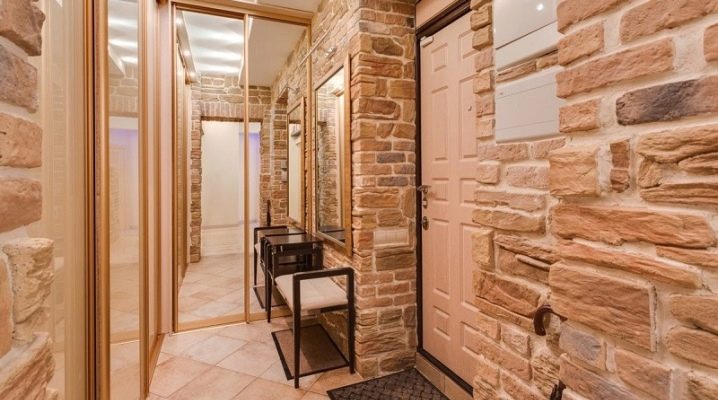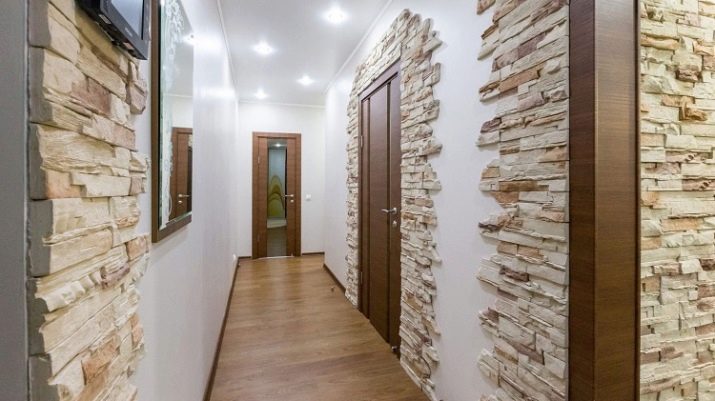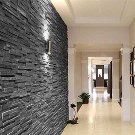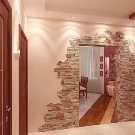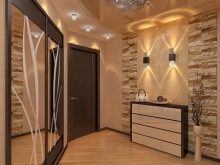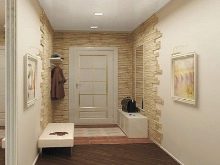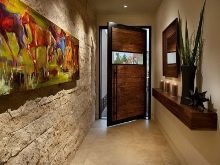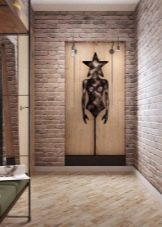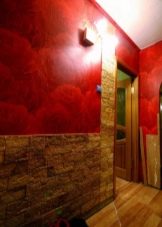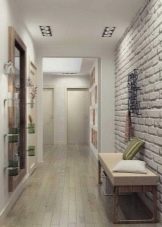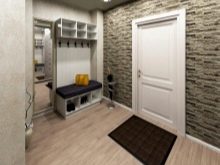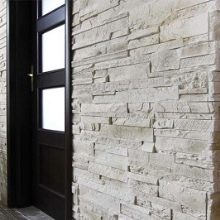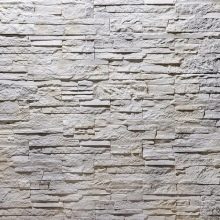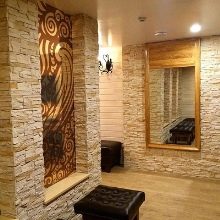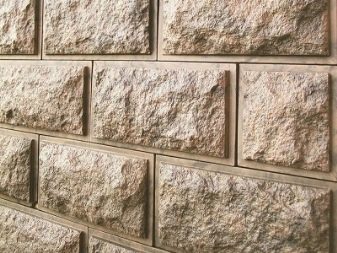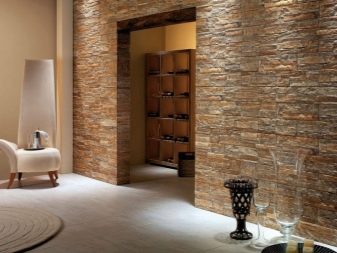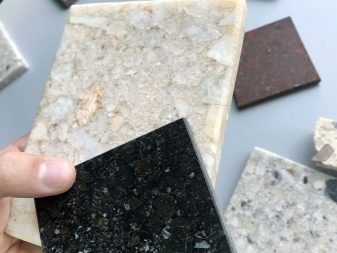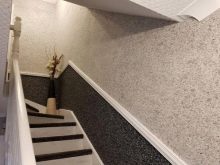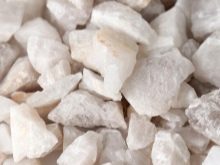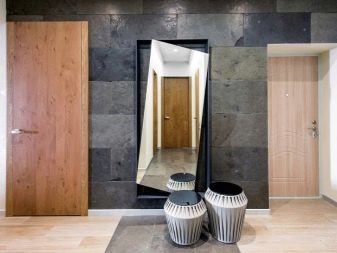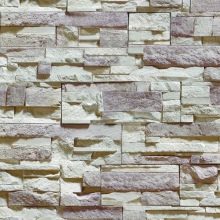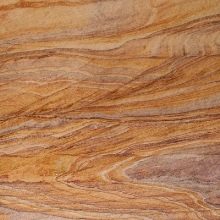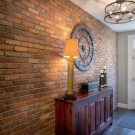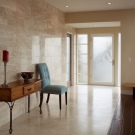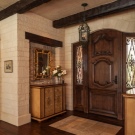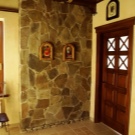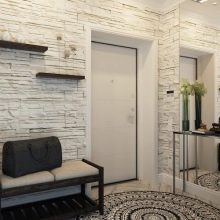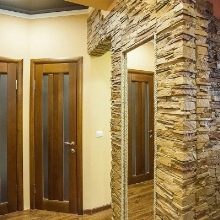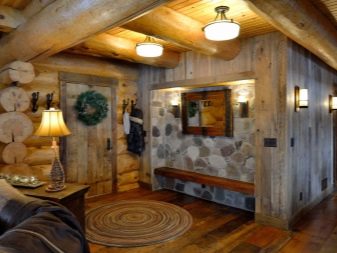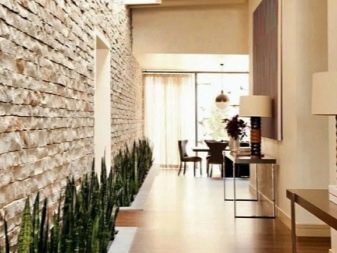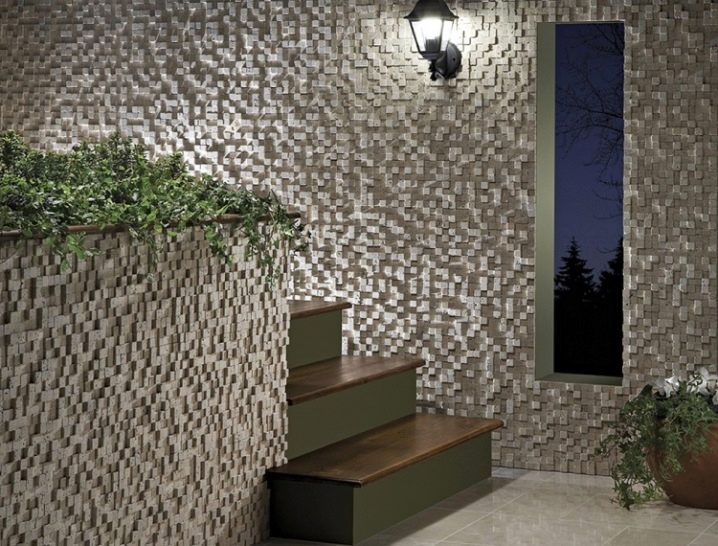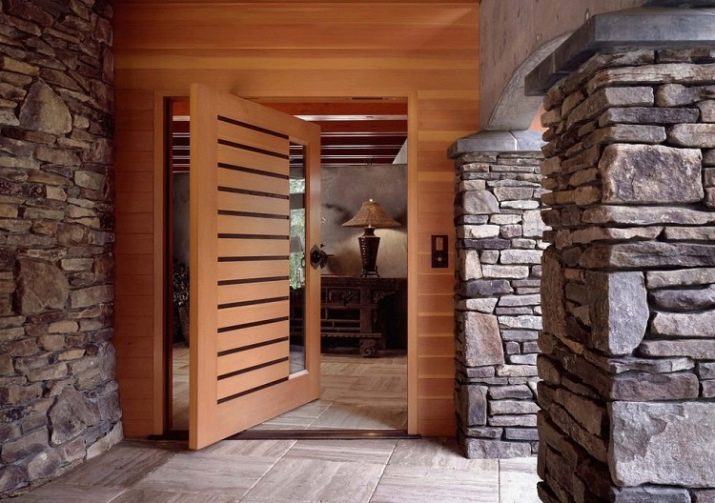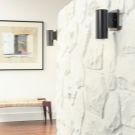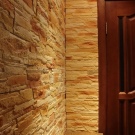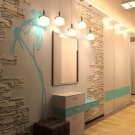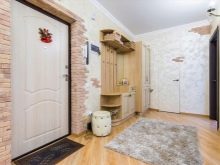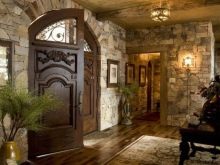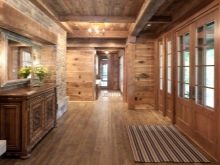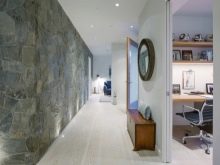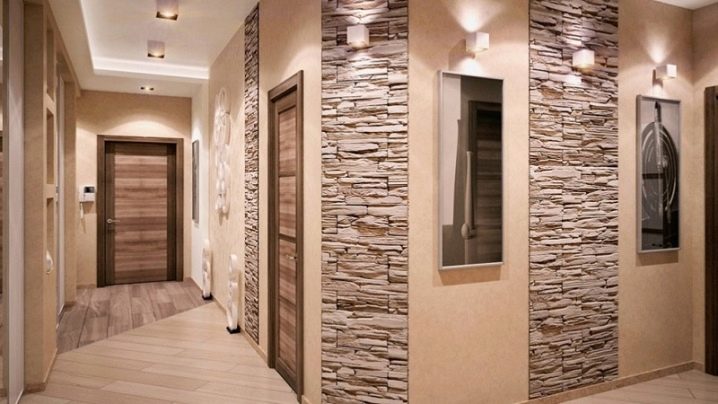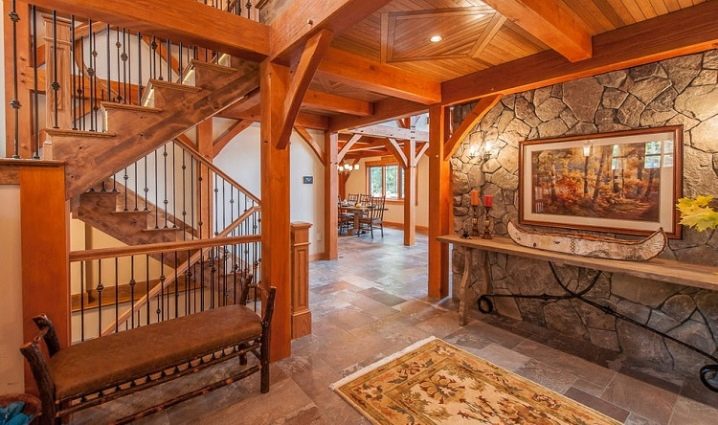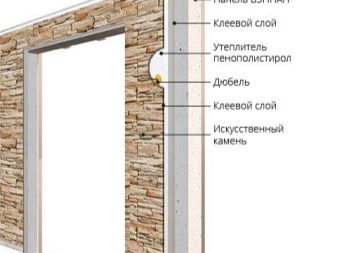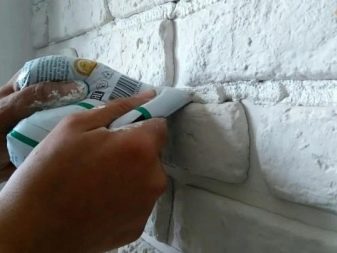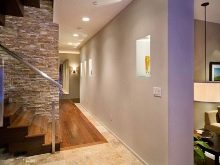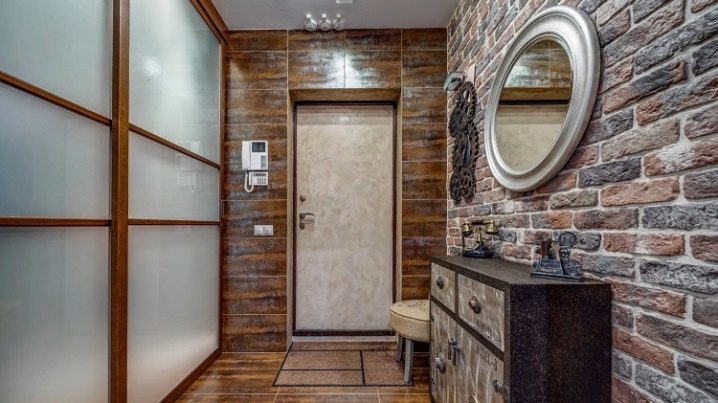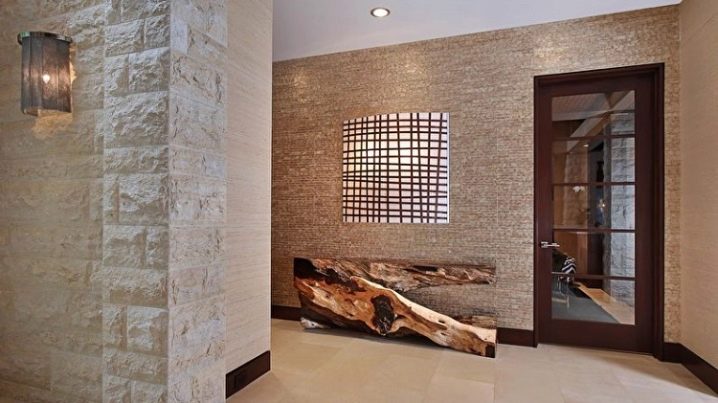Decorative stone in the hallway
The decorative stone in the hallway looks very respectable, creating a feeling of coziness and comfort. In this case, the interior design of the hall in the apartment can be made unique by emphasizing the features of the architecture, using zoning or using other techniques for decorating the premises.
It is quite possible to decorate the entrance hall with artificial stone with wallpaper or in other combinations when decorating the house with your own hands - it is easily attached to a concrete base or crate, does not require complex leveling of surfaces.
Advantages and disadvantages
Decorating the walls in the corridor always makes homeowners puzzle over the choice of material. It is important that the finish is of high quality, aesthetic, and does not require significant narrowing of the openings. Artificial decorative stone fully meets all these requirements, and also has other obvious advantages.
- Aesthetics. Like natural stone, its various imitations look very presentable. Such wall cladding can be luxurious or rough, reminiscent of medieval castles or emphasize the laconicism of a modern industrial style.
- Variety of design solutions. You can lay out only a part of the wall or a doorway with a stone, decorate all vertical surfaces with this decor. Colors, texture, surface texture are presented in all their variety. You can choose the best option, embodying the most difficult tasks.
- Light weight. Basically, it is artificial stone that is used in interior decoration - it is lighter in comparison with natural counterparts. In this case, no reinforcement of wall structures is required. The cladding is attached to them in the same way as ceramic tiles.
- Ease of installation. Cladding is carried out element-by-element or with large-format panels. In any case, it is possible to significantly reduce the time spent on fixing the material on the wall surface.
- Durability. The stone does not lose its properties for decades, retaining its strength even with intensive use. It does not fade, withstands wet and dry cleaning,
- Versatility. The stone blends harmoniously with most interior styles. You can easily add an exclusive detail in the form of such a panel or finishing of corners to the interior decoration of the hallway.
The disadvantages of decorating the hallway interior with decorative stone are also obvious. Natural materials are very massive and require a solid foundation. Stone vaults made of artificial materials look rather gloomy in low light.
In addition, the material is often perceived as a cold finish, it must be skillfully combined with other elements in order to avoid negative sensations.
Description of species
The decorative stone used in interior decoration is most often presented in the form of wall tiles or panels that allow one to reliably imitate the “wild”, rough version of facing with sandstone, limestone, and tuff. In a luxurious spacious lobby of a country house, cladding made of quartz agglomerate will be appropriate, which faithfully recreates the appearance of granite or marble. Placed on a concrete wall, imitation of masonry in the form of panels also looks very interesting, in the spirit of medieval castles or English architecture of the Victorian era.
The main classification of artificial decorative material is carried out according to the type of its basis. It is she who determines what capabilities the stone cladding will have. The most popular varieties are worth exploring in more detail.
Gypsum
Such a decorative stone is a molded product cast from a gypsum mixture in molds. The resulting materials are lightweight, with realistic relief, but they are very fragile and require additional protection from moisture. Such products are well suited for use in combination with plasterboard partitions, since they do not overload the wall surface. But the finish is less durable, not suitable for cold corridors in private houses.
From a cement-sand mixture
By the principle of its manufacture, this type of decorative stone is very similar to paving slabs. It is cast in molds, by vibropressing, dyed in bulk, giving the desired shade of the surface. Such a finish is available in the form of thin cladding panels or individual tiles, it is quite heavy, and requires careful preparation of the base during installation. The cement-sand mixture allows you to make a decorative stone that imitates cobblestone or inexpensive rocks, the surface is matte, embossed, resistant to external influences.
Finishing from such compositions is well suited for loft-style interiors, as well as for use when creating curbs, cornices. From cement varieties of stone, you can form masonry similar to clinker.
Agglomerate
This type of artificial decorative stone is used not only in wall cladding. Countertops, window sills, and other furnishings are made from it. In the production of sinter, the following are used:
- quartz;
- natural stone chips;
- binders (resins);
- coloring pigments.
This type of artificial stone is more similar to natural marble, granite, slate. Depending on the filler, the character of the pattern, strength and other characteristics of the finished material change. Agglomerate is produced both in tiles and in large-format slabs, which make it possible to form a continuous cladding on a large wall surface.
The most common version is quartz, which in combination with resins gives a very high mechanical and impact strength, comparable to granite.
A crumb of granite, marble and quartzite
Most often it is added to an acrylic or other polymer base. The resulting material takes on the appearance and properties of a mineral, a rock, while remaining light, does not overload the surface of the wall. A significant drawback of the material is its susceptibility to melting at high temperatures. Such a cladding cannot be called fireproof.
Porcelain stoneware
This material is made by analogy with ceramic tiles, by sintering clay, feldspar and coloring pigments. The mixture is pre-pressed and then fired. The resulting tile is highly durable and resistant to external influences. Porcelain stoneware always has a homogeneous structure throughout its entire thickness, it can be produced in glossy and matte versions, imitate different types of natural stone.
Slabs of this type can be square, rectangular, narrow or wide. The artificial origin of porcelain stoneware gives out only a repeating ornament - it will be the same for all modules.
The best format for cladding a corridor is considered to be a square with a side size of 300 mm and a thickness of 8 mm.
Plastic
Here, PVC or acrylic tiles are most often used, embossed panels that imitate masonry. Such material is delivered in rolls or sheets, it is inexpensive, it is easily attached both to main walls and to partitions made of gypsum, wood slabs. It is not recommended to place plastic next to heating devices, window openings. Under the influence of light, the material can turn yellow over time, and from heat it can deform.
Flexible sandstone
An innovative material that is a combination of a thin cut of natural stone and a polymer base. Finishing panels from it are elastic, flexible, easy to install. Externally, the material practically does not differ from full-fledged masonry. It does not overload the wall, retains its natural relief, and is easy to clean.
Flexible sandstone panels are more expensive than other materials. But the possibility of using natural stone in the decoration of a room, albeit in the form of a combined solution, is always attractive. The natural color scheme of the material is also a significant advantage.
Design options
Decorative stone is an ideal material for decorating a hallway. Pure white material with regular geometric shapes - square, rectangular - fits well with the aesthetics of minimalism, Scandinavian style. A ragged decorative stone of gray, red, black colors is perfect for decorating a loft-style room, a Gothic interior. In this case, the masonry itself should not be even, it is better to make it fragmentary, with separate areas covered with textured finish - in the corners, around doorways.
It is worth paying attention to how the artificial stone is painted. It can only have a surface decorative layer or be pigmented even during the preparation of the mixture. The second option is more preferable, since in case of damage, chipping of the coating, the damaged area will not be too noticeable.
In this case, the variegated masonry looks very realistic, it is impossible to visually distinguish it from natural material.
The correct choice of finishing elements also helps to diversify the interior design of the hallway. Decorative stone for small corridors is chosen from options decorated in light colors. A spacious entrance hall or hall can be finished with chocolate, black, terracotta shades.
The surface texture can also be different.
- Under rubble stone. The material imitates masonry of large boulders or pebbles. This combination looks very impressive, the relief is pronounced, therefore they usually finish the lower part of the wall or corner sections with it.
- Under the chipped stone. Such material has the appearance of embossed, untreated rock. Such a decorative stone looks good in a continuous facing of one of the walls, in the design of columns and niches.
- For sawn stone. The texture of such a finish is always clear, with a pronounced geometry. It may resemble brickwork, but with a front surface without grinding, rough, textured.
- Mosaic. In this case, the decorative panel is formed from many pieces, carefully selected in color. The composition can be matched to the interior design, shade of floor finish or furnishings.
- Tiled. It is always smooth, polished, imitating a cut of marble, granite, travertine and other types of natural stone.
- Brick. This finish imitates old or modern masonry and fits well into loft interiors.
- Fantasy. In this case, no special resemblance to natural stone is required. Unusual relief, original colors are welcomed. The finish looks impressive, it can be translucent, complemented by original lighting.
When choosing material for decorating a small hallway, you should avoid combining several types of decorative stone. It is better to give preference to the finishes with small fragments.
The spacious room allows for various combinations. The stone itself can also be more embossed, large-format.
Possible combinations
The use of decorative stone in interior decoration allows its combination with other materials. Such combinations fit especially well into the design of a narrow rectangular hallway.
Here, the completely stone decor looks too gloomy. A spacious entrance hall, finished with several materials, also looks more interesting, it allows you to highlight accent zones with relief, beat complex architectural details.
Most often, decorative stone is usually combined with some materials.
- With wallpaper. Light monochromatic coatings look especially impressive. The cladding under a wild stone with floral ornaments on the wallpaper, as well as a vertical stripe or photo prints, goes well.
- With plaster. The harmonious combination of the original texture of the base of the walls and stone is considered a classic. Usually most of the surface is plastered. Stone decor is used in the design of corners, doorways, columns and niches, if they are provided for by an architectural solution.
- With a tree. Wall cladding with clapboard under stained or smoked oak is perfectly complemented by panels with imitation of pebbles and cobblestones. They can frame the wooden sheathing with a curb, form a false fireplace.
- With ceramic tiles. In a Mediterranean design style, this finish is very popular. Marble or travertine panels are combined here with glossy glazed tiles or patchwork panels.
- With concrete. This combination looks bold, but harmonious. For combination with concrete, both quartz agglomerate and other types of stone finishes are suitable.
Original design solutions are exactly what you need to decorate the hallway. Competently combining different materials, you can easily create a stylish decor for the entrance group in the interior of a house or apartment.
Carrying out interior decoration
It is quite possible to lay out part of the walls in the hallway with decorative stone, frame doorways or corners of the room with it with your own hands. Of course, the easiest way is to stick on small and thin tiles. But massive modules are also quite successfully mounted on concrete, drywall, if you act correctly. The first thing to think about is the exact calculation of the material required for the repair. The amount of decorative stone for installation around the front door will be significantly less than what is required to cover a full wall.
The easiest way, having decided on the choice of material, is to create a drawing at a convenient scale. The walls of the hallway are drawn on it with modules of a given size inscribed in them. After experimenting with paper layouts, it should be pretty easy to get the job done in real life.
Important: when calculating the squaring of the material, it is necessary to take into account a margin of 10-15%. It falls on the fight and the pruning. Any material will inevitably have to be adapted to the specific features of the hallway. After the decorative stone is purchased, it must be laid out on the floor, checking the quality, determining the optimal seam thickness.
Consider the subsequent stages of finishing the hallway step by step.
- Surface preparation. The old coating is removed from the walls intended for decoration. Only bare concrete or plaster can be left. Then the surface is carefully primed with a cement or gypsum-based compound. Brick and wooden walls will have to be plastering beforehand.
- The choice of adhesive composition. It is determined based on the expected loads. Light materials weighing up to 30 kg / m2 are attached to some adhesives, heavy materials to others of increased strength, you can also use tile mixtures or liquid nails. It is necessary to prepare the composition during installation in small portions, using a mixer or a special nozzle on a drill, to achieve uniformity.
- Mounting. It is necessary to prime the walls again, while the primer layer dries, the glue is mixed. The wall is marked with a cord or laser level. Laying the stone starts from the corner, some manufacturers specially manufacture starting modules with a painted edge, which do not require the subsequent use of end strips.The glue is applied to the previously cleaned surface of the material using a conventional spatula, the excess is removed with a notched trowel, then the decor is firmly pressed against the wall.
- Fit. Each element in the finish is fastened by hand, knocked down to the desired tightness with a mallet.
This method is used if the decor is mounted on a small surface area. If there is a continuous installation of a large number of modules, it is better to apply the adhesive to the wall. Before laying, the decorative stone is moistened with water on the reverse side and pressed. It is worth considering the desired joining. If you plan to leave seams, you should prepare in advance special cross-shaped inserts that maintain the desired distance between adjacent masonry elements.
Excess glue protruding during installation can spoil the look of the masonry. You can avoid this by instantly removing problematic discharge. On a gypsum coating, this is done with a dry cloth, on cement, agglomerate - with a damp cloth. After the glue has completely set, the remaining seams are filled with a special grout from a construction syringe.
Beautiful examples in the interior
Decorating a hallway in an apartment or a private house using various types of decorative stone allows you to emphasize the individuality of the design solution.
An overview of beautiful examples of such projects that have already been successfully implemented in the interior will help to verify this.
- Thin overhead panels for stone in the decoration of the corner sections of the walls in the hallway can be effectively combined with other materials in natural colors.
- Combined wall decoration with porcelain tiles and brick-like stones helps to visually expand the space. The interior looks respectable, while it is not overloaded with unnecessary details.
- The cladding of a part of the hallway wall under rubble stone adds volume to the design solution. This detail unites, harmonizes the scattered parts of the interior, makes its perception more integral.
- White gypsum stone in the hallway or hall - the best solution for the embodiment of the ideas of minimalism. Against the background of contrasting borders, this finish looks especially advantageous.
